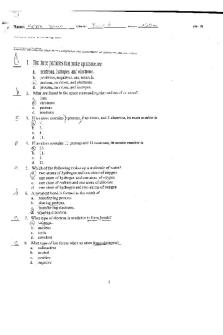Ap Bio Photosynthesis Worksheet PDF

| Title | Ap Bio Photosynthesis Worksheet |
|---|---|
| Course | AP Biology |
| Institution | High School - USA |
| Pages | 2 |
| File Size | 76.1 KB |
| File Type | |
| Total Downloads | 61 |
| Total Views | 171 |
Summary
This was a worksheet on photosynthesis answers are provided for all questions. ...
Description
Ap Bio Photosynthesis Worksheet 1) Autotrophs are “self-feeders” “solar power” the Earth. 2) Animals, Fungi, and many prokaryotes are included with heterotrophs. They depend on photosynthesis for oxygen. 3) Chloroplast is the site of photosynthesis. They are found in plant cells. 4) Chloroplast structure- an envelope of two membrane encloses the stroma, which is a dense fluid-filled area. Within the stroma is a vast network of interconnected membranous sacs called thylakoids. The thylakoids segregate the stroma from another compartment, the thylakoid space. 5) Chlorophyll is located in the thylakoid membrane and is the light-absorbing pigment that drives photosynthesis and gives plants their green color. 6) The exterior of the lower epidermis of a leaf contains many tiny pores called stomata. Carbon dioxide comes in, oxygen and water vapor goes out. 7) Photosynthesis Equation: 6CO2+6H20+Light energy = C6H12O6+ 6O2. 8) A water molecule is split during photosynthesis for its electrons, which are transferred along with hydrogen ions from water to carbon dioxide, reducing it to sugar. 9) The two cycle in photosynthesis are the calvin cycle and the light reaction. 10) Light reactions occur in the thylakoid membrane where solar energy is converted into chemical energy. 11) Light reaction: ● Light is absorbed by chlorophyll and drives the transfer of electrons from water to NADP+, forming NADPH. ● Water is split during theses reactions, and O2 is released. ● ATP is generated, using chemiosmosis to power the addition of a phosphate group to ADFP, a process called photophosphorylation. 12) The Calvin Cycle takes place in the stroma. 13) Calvin Cycle: ● CO2 is absorbed and incorporated into organic molecules in carbon fixation ● The fixed carbon plus NADPH and ATP from the light reactions in the formation of new sugars. 14) Light is electromagnetic energy, and it behaves as though it is made up of discrete particles, called photons-each of which has a fixed quantity of energy. 15) Pigments are substance that can absorb light. Chlorophyll is a pigment that absorbs violet-blue light and reflects green light.
16) An absorption spectrum is a graph plotting a pigment light absorption versus wavelength. 17) The action spectrum for photosynthesis graphs the efficiency of different wavelength of light in driving the process of photosynthesis. 18) Two parts of photosystem: 1. Light harvesting complex 2. Reaction center 19) Light harvesting complex is made up of many chlorophyll and carotenoid molecules (accessory pigments in the thylakoid membrane). 20) When chlorophyll absorbs light energy in the forms of photons, one of the molecule’s electrons is raised to an orbital of higher potential energy. 21) Reaction center: consists of two chlorophyll a molecules, which donates the electrons to the second member of the reaction center, the primary electron acceptor. The solar-powered transfer of an electron from the reaction-center chlorophyll a pair to the primary electron acceptor us the first step if the light reactions. This is the conversion of light energy to chemical energy. 22) Photosystem I is also called P700 because the chlorophyll a in the reaction center of this photosystem absorbs red light of this wavelength the best. Photosystem II is also called P680 for the same reason. 23) Linear electron flow is the flow of electrons through the photosystems in the thylakoid membrane. Cyclic electron flow uses PS I and PS II. Cyclic electron flow uses a short circuit of linear electron flow by cycling the excited electrons back to their original starting point in PS I. 24) Chemiosmosis in photosynthesis transform light energy to chemical energy. 25) The key difference between chemiosmosis in cellular respiration and chemiosmosis in photosynthesis is that the mitochondria (CR) to transport chemical energy from food molecules to ATP, where chloroplast (photosynthesis) transform light energy into chemical energy in ATP....
Similar Free PDFs

Ap Bio Photosynthesis Worksheet
- 2 Pages

AP Bio Photosynthesis Lab
- 1 Pages

Photosynthesis-worksheet
- 4 Pages

Photosynthesis-Worksheet
- 3 Pages

Photosynthesis Notes AP Biology
- 6 Pages

Bio hw 7 photosynthesis
- 4 Pages

AP Bio Proteins
- 1 Pages

AP Bio Mendelian Genetics
- 3 Pages

AP. Bio. Test - test
- 4 Pages

AP Bio Linked Genes
- 3 Pages

AP Bio Nondisjunction
- 1 Pages
Popular Institutions
- Tinajero National High School - Annex
- Politeknik Caltex Riau
- Yokohama City University
- SGT University
- University of Al-Qadisiyah
- Divine Word College of Vigan
- Techniek College Rotterdam
- Universidade de Santiago
- Universiti Teknologi MARA Cawangan Johor Kampus Pasir Gudang
- Poltekkes Kemenkes Yogyakarta
- Baguio City National High School
- Colegio san marcos
- preparatoria uno
- Centro de Bachillerato Tecnológico Industrial y de Servicios No. 107
- Dalian Maritime University
- Quang Trung Secondary School
- Colegio Tecnológico en Informática
- Corporación Regional de Educación Superior
- Grupo CEDVA
- Dar Al Uloom University
- Centro de Estudios Preuniversitarios de la Universidad Nacional de Ingeniería
- 上智大学
- Aakash International School, Nuna Majara
- San Felipe Neri Catholic School
- Kang Chiao International School - New Taipei City
- Misamis Occidental National High School
- Institución Educativa Escuela Normal Juan Ladrilleros
- Kolehiyo ng Pantukan
- Batanes State College
- Instituto Continental
- Sekolah Menengah Kejuruan Kesehatan Kaltara (Tarakan)
- Colegio de La Inmaculada Concepcion - Cebu




